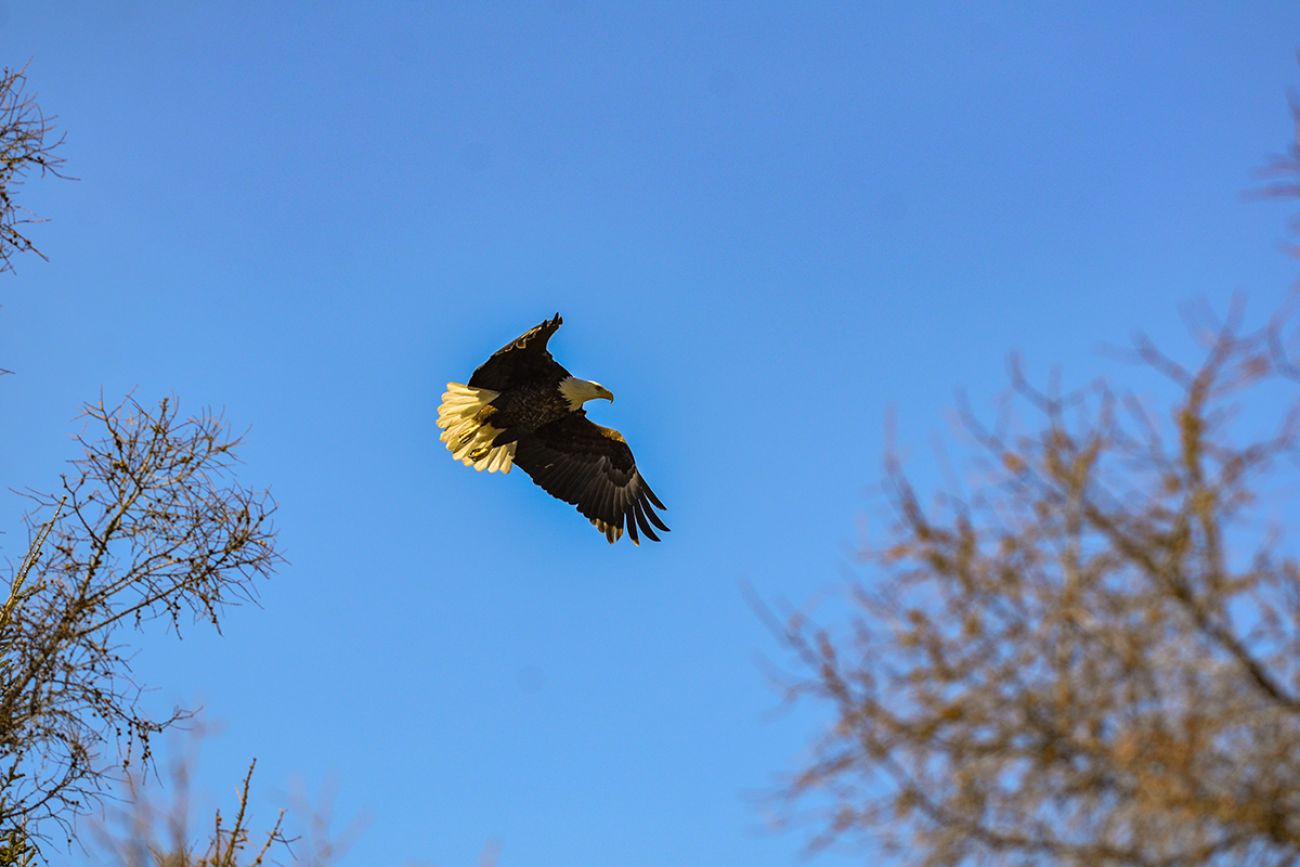Bird flu has killed at least 18 Michigan eagles this year. More deaths feared

- In 2022, highly pathogenic avian influenza hit Michigan’s eagle population
- Research shows the disease reduced breeding pairs in the state by about 40%
- So far this year, at least 18 Michigan eagles died from bird flu, according to lab tests
In February, a bald eagle was found in Bellaire, Antrim County, struggling to take flight, flapping her wings as she twisted in lopsided circles in the snow. After a concerted effort, she gave up and rested on her belly, breathing heavily.
The eagle was taken to the Skegemog Raptor Center in Grand Traverse County, where she was quarantined and tested for avian influenza, or bird flu. The results came back positive.
“Sadly, we had to provide a humane end,” James Manley, the center’s executive director, posted on social media alongside a video of the eagle.
That bird was one of at least 18 eagles in Michigan that have lost their lives to bird flu so far this year, according to testing data provided by the Michigan Department of Natural Resources’ Wildlife Disease Laboratory. Results from 16 more suspected cases are pending. If they come back positive, that could bring the total to 34.

Ups and downs
In the middle of the last century, the nation’s eagle population was devastated by the introduction of the insecticide dichloro-diphenyl-trichloroethane or DDT. It wreaked havoc on eagles which, as predators, ingested the chemical compound in high concentrations. But then, starting in 1972, a series of steps were taken to restore the eagle population. DDT was banned, bald eagles became federally protected, and some eagles were bred in captivity before being released into the wild. In Michigan, annual aerial surveys showed breeding pairs rose from 52 in 1961 to about 835 in 2017. Eagles had bounced back.
Still, the birds weren’t without threats. Car crashes and lead poisoning are consistent causes of death for Michigan’s eagles. Disease is usually less of a threat, but that changed three years ago.
What to learn more about threats to Michigan’s bald eagles?
The Skegemog Raptor Center and Green Elk Rapids are hosting an event featuring Michigan Department of Natural Resources pathologist Julie Melotti. She’ll talk about the latest findings on highly pathogenic avian influenza and lead poisoning in eagles.
Date: Sunday July 13
Time: 1 p.m.
Location: Edward C. Grace Memorial Harbor Pavilion, 129 North Cedar Street, Elk Rapids, MI 49629
HPAI hits Michigan eagles
In 2022, highly pathogenic avian influenza, a severe type of bird flu, hit Michigan. That year, the Wildlife Disease Lab found 71 eagles it tested died of the disease.
“They’re a population that, if there’s going to be some sort of impact, they’re going to be really slow to rebound,” said Julie Melotti, the pathologist for the Wildlife Disease Lab.
Related:
- Avian flu has killed over 300 geese, other wild birds in Michigan, state says
- Return of bald eagles to the Great Lakes could hold lessons for humans
- Michigan bald eagles soar back from near-extinction
Unlike rabbits or mice that reproduce rapidly, bald eagles take five years to mature and then lay two to three eggs a year.
Bill Bowerman, a University of Maryland researcher who’s been studying eagles since the 1960s, is looking into the impact bird flu’s had on Michigan’s eagle population for a forthcoming study. While disease normally accounts for about 6% of the deaths of Michigan eagles tested in the lab, Bowerman’s team found that, in 2022, disease accounted for about 40% of lab-tested deaths, with the overwhelming majority testing positive for highly pathogenic avian influenza.
Sign up for our outdoors newsletter
Want more coverage like this delivered directly into your inbox? Sign up for the Bridge Michigan Outdoors newsletter here.
This had a significant impact on the population, Bowerman said. Eagle populations are often measured in terms of breeding pairs, couples aged five or older occupying nests. In Michigan, Bowerman’s team found pairs went from 1,085 in 2022 to 633-671 in 2023, a reduction of about 40%.
“It’s a little shocking,” he said. “It was a really major population-level impact. But with 600-some pair still around, it’s not like we’re going to trigger listing them (as endangered species) again. But we need to continue to monitor.”
After 2022, the number of eagles testing positive for bird flu went down, with fewer than 10 positive cases in 2023 and 2024 combined. But highly pathogenic avian influenza is still spreading, and case numbers appear to be going back up.
Bowerman has his eye on the U.S. Geological Survey’s modeling of the spread of avian influenza around the world.
“We're waiting to see if there's another wave going to come through, which is what they predict,” he said.
See what new members are saying about why they donated to Bridge Michigan:
- “In order for this information to be accurate and unbiased it must be underwritten by its readers, not by special interests.” - Larry S.
- “Not many other media sources report on the topics Bridge does.” - Susan B.
- “Your journalism is outstanding and rare these days.” - Mark S.
If you want to ensure the future of nonpartisan, nonprofit Michigan journalism, please become a member today. You, too, will be asked why you donated and maybe we'll feature your quote next time!




